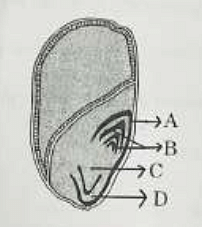Identify the part of the seed from the given figure which is destined to form root when the seed germinates.

Identify the part of the seed from the given figure which is destined to form root when the seed germinates.

- A
- B
- C
- D
The Correct Option is C
Solution and Explanation
In a seed, the part that forms the root during germination is called the radicle, which is located at the base of the embryo. From the given figure, the part labeled C corresponds to the radicle.
\[ \begin{array}{|c|c|} \hline \textbf{Seed Part} & \textbf{Function} \\ \hline \text{Radicle (C)} & \text{Develops into the root} \\ \text{Plumule} & \text{Develops into the shoot} \\ \text{Cotyledons} & \text{Store food for the developing seedling} \\ \hline \end{array} \]
Thus, the correct answer is (3) C.
Top Questions on The Seed
- In the seeds of cereals, the outer covering of endosperm separates the embryo by a protein-rich layer called:
- What is the ideal seed rate for okra for rainy season crop?
- Which of the following is true for essentiality of germination? (A) Viability of seed
(B) Proper environment
(C) Seed free from dormancy
(D) Thin seed coat - Which of the following annuals require the isolation distance of 50-100 meters for seed production?
(A) Antirrhinum
(B) Marigold
(C) Larkspur
(D) Nasturtium
Choose the correct answer from the options given below: - Given below are two statements:
Statement (I): The non deep type is the most common primary dormancy
Statement (II): In this type of dormancy species require light or darkness to germinate or chilling stratification
In light of the above statements, choose the most appropriate answer from the options given below
Questions Asked in NEET exam
- C(s) + 2H$_2$(g) $\rightarrow$ CH$_4$(g); $\Delta H = -74.8 \, \text{kJ mol}^{-1}$
Which of the following diagrams gives an accurate representation of the above reaction?- NEET (UG) - 2025
- Chemical Kinetics
Predict the major product $ P $ in the following sequence of reactions:
(i) HBr, benzoyl peroxide
(ii) KCN
(iii) Na(Hg), $C_{2}H_{5}OH$- NEET (UG) - 2025
- Organic Chemistry
Consider a water tank shown in the figure. It has one wall at \(x = L\) and can be taken to be very wide in the z direction. When filled with a liquid of surface tension \(S\) and density \( \rho \), the liquid surface makes angle \( \theta_0 \) (\( \theta_0 < < 1 \)) with the x-axis at \(x = L\). If \(y(x)\) is the height of the surface then the equation for \(y(x)\) is: (take \(g\) as the acceleration due to gravity)

- NEET (UG) - 2025
- Surface Tension
- From the statements given below, choose the correct option: (A) The eukaryotic ribosomes are 80S and prokaryotic ribosomes are 70S.
(B) Each ribosome has two sub-units.
(C) The two sub-units of 80S ribosome are 60S and 40S while that of 70S are 50S and 30S.
(D) The two sub-units of 80S ribosome are 60S and 20S and that of 70S are 50S and 20S.
(E) The two sub-units of 80S are 60S and 30S and that of 70S are 50S and 30S.
Choose the correct answer from the options given below:- NEET (UG) - 2025
- Protein Synthesis
AB is a part of an electrical circuit (see figure). The potential difference \(V_A - V_B\), at the instant when current \(i = 2\) A and is increasing at a rate of 1 amp/second is:

- NEET (UG) - 2025
- Electromagnetic Induction and Inductance